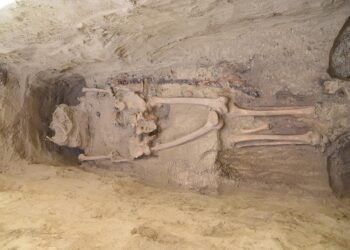A remarkable fossil discovery in northeastern China has shed light on an extraordinary event that occurred around 125 million years ago, showcasing a mammal attacking a much larger plant-eating dinosaur.

The fossil, found in the Liaoning Province, challenges the conventional belief that dinosaurs had little to fear from their smaller contemporaries.
The fossil shows a ferocious badger-like mammal, identified as Repenomamus robustus, engaging in a fierce confrontation with the two-legged dinosaur, Psittacosaurus lujiatunensis. The mammal, about the size of a domestic cat, is shown grappling with the medium-sized dog-sized dinosaur, providing evidence of predatory behavior by a mammal towards a dinosaur—a phenomenon that had not been previously recorded.
Researchers, including Dr. Jordan Mallon, a paleobiologist from the Canadian Museum of Nature, who helped lead the study published in the journal Scientific Reports, were astounded by the significance of the discovery.
“Dinosaurs nearly always outsized their mammal contemporaries, so traditional belief has been that their interactions were unilateral — the bigger dinosaurs always ate the smaller mammals,” he said. However, the fossilized evidence challenges this notion, revealing a more intricate and complex Mesozoic food web.
The well-preserved fossil, known as the “Chinese Pompeii,” was unearthed in an area known for its volcanic eruptions that swiftly buried various animals, leading to an astonishing level of preservation.
Unlike many fossils, this particular one captures the interactions between animals during their final moments. The positioning of Repenomamus atop the Psittacosaurus, gripping the dinosaur’s jaw and hind leg while biting into its ribcage, suggests an active attack rather than scavenging behavior.

The predator-prey relationship between Repenomamus and Psittacosaurus is further supported by the lack of tooth marks on the dinosaur’s bones, indicating that the mammal hunted its prey while it was still alive. The weight of evidence indicates that the mammal did not stumble upon a carcass but actively sought out and attacked the dinosaur.
The discovery provides crucial information into the complexity of Mesozoic food webs, indicating that interactions between mammals and dinosaurs were more intricate than previously believed. It is rare to find fossils that offer such detailed glimpses into ancient animal behavior, making this discovery a truly exceptional specimen for paleontologists.
Dr. Mallon and his team are confident in the authenticity of the fossil and expect that further analysis of the volcanic deposits in the region will continue to reveal new evidence of interactions among various species.
This extraordinary fossil serves as a window into a bygone era, providing invaluable knowledge about the natural history of our planet and the interplay between different species that once roamed the Earth. It showcases the fierce struggles for survival that played out in prehistoric times, where even small mammals could prove themselves as formidable hunters.






















